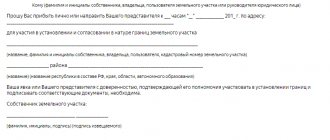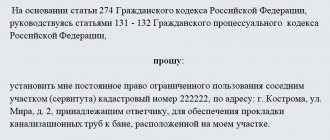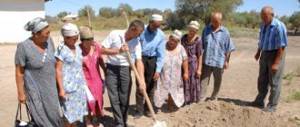It’s so established that if it’s property, then it’s property, and it must be someone’s. In our country, nothing is abandoned; everything is in order. Accordingly, it should be concluded that when acquiring (by any possible means) land, it is necessary to document ownership.
A document that includes technical data, information about the owner and other information is called the “Cadastral Passport of the Land Plot”.
When registering a land plot, it is assigned the appropriate cadastral data, namely:
- Cadastral address;
- Cadastral number;
- Full name of the owner;
- The boundaries and number are written down;
- Technical data.
The legal basis of land ownership is regulated by the Land Code, which also reflects the classification of forms of ownership:
- Private property. Private property means the ownership and disposal of a land plot by an individual or legal entity, according to which any work, events and other actions must be accompanied either by the personal participation of the owner or under his control through representatives. Ownership of private property occurs after the acquisition of a plot and registration of the relevant documents.
- Municipal property. Municipal property is a territory subordinate to the municipality on the basis of:
- Open.
Closed.
Moreover, such property can be of two types:
- Law.
- Distinctions.
Thus, we find that the first group includes land available for use by all citizens of the Russian Federation, and the second group includes areas where entry is strictly limited.
Where to go
There are several authorities where accurate information about land is stored; not only the owner can contact any of them to make sure what data is listed in relation to his property. But according to the law, other interested parties also have this right.
FUGRTs
The Federal Office of the State Registration Center (FUGRC) must register all plots, the rights to which are transferred to any person (individual or legal). This requirement was established by Federal Law No. 122 (07/21/97) and the Civil Code, Art. 131.
Article 131. State registration of real estate
Rosreestr stores the most complete and accurate information about lands that have been registered. The applicant can receive it in the form of an extract. To do this, you will need to submit an application and pay a state fee, an individual must present a passport, and a legal entity must present constituent documents.
If there is no information about the plot in the registration chamber, this indicates that its owner is still the state. The applicant needs to know that at the beginning of 2020, the Unified State Register of Rights (USRP) and the State Real Estate Cadastre (SRN) were merged into Rosreestr. Therefore, today it is enough to obtain an extract from the Unified Real Estate Register; information about the real estate itself and the person who has the rights to own or use it will be stored there.
To obtain an extract, you can contact the territorial office of Rosreestr or through an intermediary:
- MFC;
- State Services portal;
- official website of Rosreestr;
- by mail, sending a request by registered mail.
Administration
Another source of information is local authorities, but how can you find out who owns a plot of land? Send a request to the interested party to the municipal property department.
It is the district municipalities and village council administrations that store information about the lands that are under their department. If land surveying has already been carried out at the expense of budget funds, then the information will also be stored with local authorities.
Gardening Partnership
If the plot belongs to a gardening partnership, then most often all the land is collectively owned. But if a member of the partnership was privatized, then the land he used became his property. Any information can be provided by the chairman in the form of an extract from the household ledger.
In the event that privatization was not completed by the owner of a specific plot owned by the cooperative, or the municipality refused to transfer ownership of it, the applicant, after receiving the information, will not be able to buy it.
A purchase and sale transaction is possible only on an informal basis, when the concluded agreement cannot subsequently be recognized as valid. But he will be able to register for membership in a gardening cooperative and obtain rights to use the site. In this case, the old owner must refuse them and leave the partnership, having previously paid all contributions. In any case, before concluding a transaction, it is better for the applicant to familiarize himself with information about the land.
Tax
From the moment the site passes state registration and within 10 days, information about it is transferred from Rosreestr to the Federal Tax Service, specifically to the territorial office that has jurisdiction over these territories. After all, any real estate object has a location and address, and it is based on this information that the data is distributed among the territorial branches of the Federal Tax Service.
It is established by law that the owner pays land tax on time. Naturally, information about all taxpayers is stored in the tax service. By contacting the territorial branch of the National Assembly, the applicant will have to explain why he needed this information.
The difference between new buildings and “old” houses
The request was accepted in accordance with all necessary norms and regulations. This territory began to belong to the municipality of the settlement and was used to meet the needs of the residents of the said village.
EGRN. This can be done in person through the territorial office of Rosreestr, MFC, or online. The information is considered accessible, so it can be obtained by anyone.
For 400 rubles, you can go to the nearest MFC “My Documents” and order a paper version of the extract from the Unified State Register of Taxpayers there. Such a document will be signed by the registrar and have a large blue seal of Rosreestr.
Study of the selected territory for the presence of vacant land plots. On the left side of the map menu you will need to select the “Manage Map” button.
Another situation in which such data may be needed may be as follows. Let's say you are looking for a piece of land for some purpose. And so, you see that there is an area that, at first glance, looks ownerless. They don’t look after the land; everything is overgrown with weeds. There are no houses or other buildings, or they are badly damaged over time. An interested person who wants to find out the owner of the land can obtain the requested information from the territorial divisions of Rosreestr by paying a state fee. After receiving the request, employees of the registration authority will issue the applicant an extract from the Unified State Register, which will contain information about the owner of the land of interest.
How to find out who owns a plot of land
Information about land is most often needed by persons who plan to buy or buy it from the state, or lease it. Perhaps the plot you like is abandoned, and the neighbors do not have information about the real owner. In another case, the owner of the plot wants to expand its borders at the expense of nearby land. There can be many reasons.
If an interested person only requires data about the site itself, which can be gleaned from technical documents, then it is enough to contact the chamber of state cadastre and cartography.
There you can find out:
- what is the area of the land;
- where, according to documents, its borders lie;
- when was the last survey carried out?
- what is the individual site number;
- his exact address;
- other data.
Therefore, an interested person can submit an application, indicating his data and the reason for his interest. However, it is impossible to find out in the State Cadastre whether a citizen or legal entity has completed the procedure, registered the property as a property or leased it. It is impossible to find out who owns the land ownership rights here.
By cadastral number
If the interested person knows the cadastral number of the plot, then it can be used to contact any authority that is involved in the process of registering rights or registering the land with cadastral registration. But most often the applicant for land is interested in property rights that were registered by some person.
From papers based only on the cadastral number, you can order an extract from:
- EGRN. This can be done in person through the territorial office of Rosreestr, MFC, or online. The information is considered accessible, so it can be obtained by anyone. It is also possible to obtain an extended version of the extract, but it will be provided only to the owner of the plot and after the owner presents a certificate of registration.
- Household book.
- State Cadastre.
The cost of a land plot is established after its special assessment. Here you can claim to restore the boundaries of the land plot.
In some cases, the applicant may be refused and an extract will not be issued if:
- the state duty has not been paid;
- a receipt for payment of the state fee was not attached to the application;
- information about the site is not in the database;
- Gross errors were made when filling out the application;
- it turned out that the documents attached to the application were invalid;
- federal legislation imposed restrictions on the release of information about specific land;
- It is impossible to identify the site using the data specified in the application.
If there is no number
When an interested person does not have a cadastral number, the easiest way for him to contact the local administration to which this plot is assigned. But for this you need to at least know his address. If the interested person has neither one nor the other, then you can turn to a special application that Rosreestr has posted on the Internet.
To access information posted in the form of an interactive map, you need to indicate the approximate location of the site, then find out its exact address, which the program will give. Having the address of the land, you can also contact one of the authorities.
By the address
When the interested person only has the address of the land, and possibly a cadastral diagram of its location, he should contact the cadastral chamber.
Data about the site is issued within about a week; specialists will do an extended search in 10 days:
- But first, you should still ask whether the site is registered with the State Cadastre at all. For this purpose, you can use the Public Cadastral Map (pkk5.rosreestr.ru); if the plot is not there, this means that there is no information about it, which means you can only contact local authorities.
- If a site is not listed on the Public Map, it can be concluded that it cannot become the subject of transactions. But it may turn out that the site is on the cadastral map, but its status is defined as “previously recorded”. This means that there is information in the database, but it needs to be corrected. Therefore, cadastral work will have to be organized.
- There are other statuses that an interested party may find on the public map for a particular site. For example, “temporary” or “no information about boundaries.” This means that land surveying work was carried out, but the data was not entered into the database or is planned to be entered later.
- When the interested party finds out the status of the land, he will be able to estimate the costs associated with registering it. Most likely, you will have to do this at your own expense.
- On the cadastral map, using the plot number, the applicant will also be able to find out what category of land it belongs to and its type of permitted use. This information is very important for the interested party. Perhaps the land suits him according to other parameters, but he will not be able to carry out the activities he intended on it. Therefore, the question of who has registered ownership rights to real estate becomes irrelevant.
- With the help of the Public Map, only by the address of the site, the user will definitely find out where the power line is located nearby, communication lines, roads and railway lines are located, a pipeline has been laid, and there are important strategic objects that may be harmful to human health.
A cadastral map is a convenient tool that can be used not only by individuals and businesses, but also by potential investors. But the information received is only superficial; one can first assess the attractiveness of the site for investment.
Other ways to obtain information about the owner of the land
Some government agencies may also have information about copyright holders:
- tax service;
- local administration at the location of the site;
- Garden community.
You can contact any of these organizations with a request to provide information about the rights holders of a land plot. However, there is a possibility that information about the owner will not be disseminated unless the applicant has some relationship with the owner.
Dear readers, the information in the article may be out of date, please take advantage of a free consultation by calling: Moscow +7(499)350-80-59 , St. Petersburg +7(812)309-94-01 or via the feedback form below.
Article updated: May 3, 2020
We remind you that there are no ways to find out the passport details of the owners of a land plot in our article. Passport data belongs to the category of personal data, therefore it is prohibited to distribute and use it without the permission of the citizen
. With the help of our article, you can find out only the full names of the owners or, if the site is owned by an organization, then its name.
The verification method is the same as with an apartment. These articles are similar, only the instructions are slightly changed
.
Because to find the right site you need its exact address, and many people wrote to us by email that not everyone knew it. It’s okay, because you can find a site using an online map, where its exact address will be displayed
. For ourselves, we found the most convenient search service and included it in the instructions. But first, let's dispel the main myth.
Rosreestr portal
The next way to find out the legal owner of the land is to contact the official website of Rossreestr, which can be accessed from the “Services” tab on the public cadastral map or at https://rosreestr.ru. Data on the owners of all land plots is contained in the Unified State Register of Real Estate (USRN). Any citizen who has submitted an application and paid the state fee has the right to receive an extract from the real estate register for a certain plot.
To order an extract, you need to know the cadastral number or address of the land plot.
You can order an extract in the following ways:
- at a branch of Rosreestr;
- multifunctional center;
- on the Public Services Portal;
- on the official website of Rosreestr.
How to order an extract from the Unified State Register of Real Estate online
To obtain information about the owner of a plot of land online, you should use the official website of Rosreestr.
On the main page of the Portal, select the section “Electronic Services”, then “Obtaining information from the Unified State Register of Real Estate”
In the window that opens, you will need to fill out four steps to fill out the required information form. Please pay attention to the required lines (marked with an exclamation mark):
At the first stage of filling out the form, information about the land plot, cadastral number, area, location, as well as an email address where an extract can be received in electronic form are indicated. In addition, the type of document in which the extract will be received (electronic or paper) is indicated.
The next step in filling out the form is to provide information about the applicant. The type of applicant, personal data and information from an identity document are indicated. In the same tab, you can select the applicant’s representative, as well as indicate your mailing address to receive an extract by mail. At this stage of filling out, it is necessary to confirm the applicant’s consent to the processing of his data (by checking the appropriate box).
After filling out information about the site and the applicant, you will need to attach the relevant document. A copy of the civil passport or power of attorney for the representative. The attached document must be signed with the electronic digital signature of the applicant and a signed digital signature file must be attached.
. If there is no representative of the applicant, this step can be skipped by clicking on the “Proceed to data verification” button.
The final step is to check all entered data. If you find inaccurate data, you can correct it.
After checking the completed information, you must click on the “Send request” button. An extract request will be automatically generated and will also be assigned a number and password by which you can track the status of the request.
After some time, a letter will be sent to the specified email address with detailed instructions on how to pay for services for providing an extract from the Unified State Register. The payment amount depends on the type of document received (electronic or by post) and ranges from 300 rubles
. You can pay in any convenient way: by credit card, e-wallet or other suitable method.
Within the prescribed period (three working days), an extract from the Unified State Register will be provided to the applicant; the owner of the required land plot will be indicated in the right holder line. In addition, the extract indicates the date of state registration of the right and the basis for the arising right.
If you choose the delivery method by mail, the period for receiving the statement may be extended by the time of delivery by mail.








